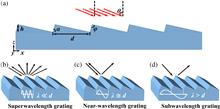Search by keywords or author
Journals >Advanced Photonics Nexus
Export citation format
Research Articles
Surface plasmon resonance-based absorption across scales from superwavelength to subwavelength gratings
Zhisen Huang, Qian Zhang, Qiang Song, Shanwen Zhang, and Changhe Zhou
Metal micro-nano grating has received much attention due to its ability to provide high-efficiency light absorption. However, the current research scales of these metal gratings are focused on subwavelengths, and little attention has been paid to the absorption properties of metal gratings at other scales. We investigaMetal micro-nano grating has received much attention due to its ability to provide high-efficiency light absorption. However, the current research scales of these metal gratings are focused on subwavelengths, and little attention has been paid to the absorption properties of metal gratings at other scales. We investigate the absorption properties of metal gratings based on surface plasmon resonance (SPR) across the scales from superwavelength to subwavelength. Under grazing incidence, we observe continuous strong absorption phenomena from superwavelength to subwavelength Al triangle-groove gratings (TGGs). Perfect absorption is realized at the subwavelength scale, whereas the maximum absorption at all other scales exceeds 74%. The electric field distribution gives the mechanism of the strong absorption phenomenon attributed to SPR on the surface of Al TGGs at different scales. In particular, subwavelength Al TGGs have perfectly symmetric absorption properties for different blaze angles, and the symmetry is gradually broken as the grating period’s scale increases. Furthermore, taking Al gratings with varying groove shapes for example, we extend the equivalence rule of grating grooves to subwavelength from near-wavelength and explain the symmetric absorption properties in Al TGGs. We unify the research of metal grating absorbers outside the subwavelength scale to a certain extent, and these findings also open new perspectives for the design of metal gratings in the future..
Advanced Photonics Nexus
- Publication Date: Mar. 18, 2025
- Vol. 4, Issue 3, 036001 (2025)
On-chip high-energy photon radiation source based on near-field-dielectric undulator
Fu-Ming Jiang, Xin-Yu Xie, Chengpu Liu, and Ye Tian
A new on-chip light source configuration has been proposed, which utilizes the interaction between a microwave or laser and a dielectric nanopillar array to generate a periodic electromagnetic near-field and applies periodic transverse acceleration to relativistic electrons to generate high-energy photon radiation. TheA new on-chip light source configuration has been proposed, which utilizes the interaction between a microwave or laser and a dielectric nanopillar array to generate a periodic electromagnetic near-field and applies periodic transverse acceleration to relativistic electrons to generate high-energy photon radiation. The dielectric nanopillar array interacting with the driving field acts as an electron undulator, in which the near-field drives electrons to oscillate. When an electron beam propagates through this nanopillar array in this light source configuration, it is subjected to a periodic transverse near-field force and will radiate X-ray or even γ-ray high-energy photons after a relativistic frequency up-conversion. Compared with the undulator which is based on the interaction between strong lasers and nanostructures to generate a plasmonic near-field, this configuration is less prone to damage during operation..
Advanced Photonics Nexus
- Publication Date: Apr. 02, 2025
- Vol. 4, Issue 3, 036002 (2025)







